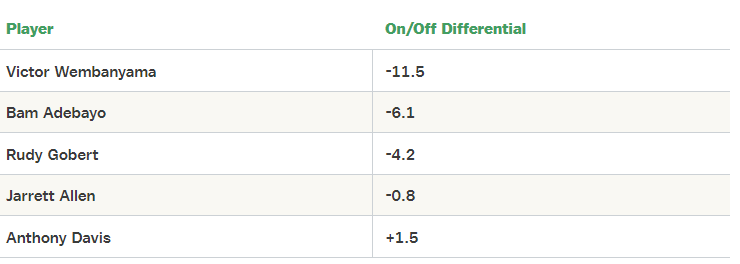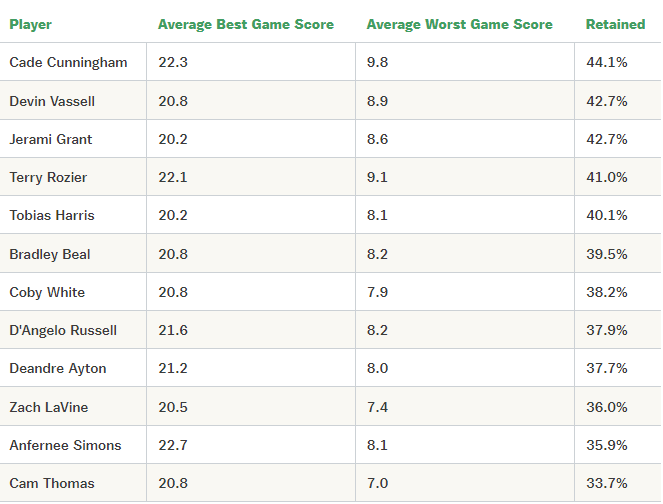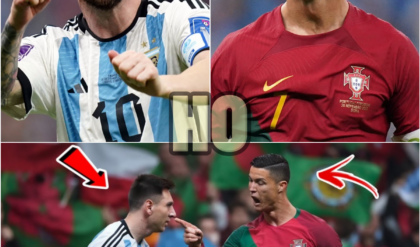/cdn.vox-cdn.com/uploads/chorus_image/image/73222916/KramSession032124_Getty_AP_Ringer.0.jpg)
Each Thursday of the NBA season, we’re analyzing a grab bag of topics from around the league. This week, we’re examining Victor Wembanyama’s defensive impact, the Los Angeles Lakers and Golden State Warriors’ collision course to the play-in, the NBA’s most and least consistent stars, and more. This is the Kram Session.
Under Review: Breaking Down Victor Wembanyama’s DPOY Case
Rudy Gobert is the heavy favorite to win the Defensive Player of the Year award. It would be the fourth win of his career, tying him with Ben Wallace and Dikembe Mutombo for the most in NBA history, and a welcome change of pace after he spent last season as a narrative punching bag following his lopsided trade to the Timberwolves.
It’s easy to make a case for Gobert in his bounceback season, as he’s the best defender on the best defensive team in the league. FanDuel odds as of Wednesday give him an 80 percent implied probability to win.
Behind Gobert, the second-best odds belong to Spurs rookie Victor Wembanyama, at 16 percent; nobody else has better than a 1 percent chance. The main area of separation between the top two candidates is massive and important: Gobert’s team leads the NBA in defensive rating, while Wembanyama’s ranks 23rd. Open and shut, case closed.
But should it be? That simple comparison strips out crucial context that surrounds both French centers’ defensive performances. If Anthony Edwards and Jaden McDaniels played in San Antonio, the Spurs defense would rank a lot better. Individual defense remains tricky to measure, but Wembanyama has a convincing case to not only become the first rookie since Tim Duncan to make an All-Defensive team, but to win DPOY outright.
The first argument in Wembanyama’s favor is that he dominates the defensive box score stats. He leads the league with 3.5 blocks per game (nobody else has more than 2.6) and adds 1.3 steals as well, despite various minutes limits throughout the season. The only other player in the last 15 years to average at least three blocks and one steal per game was Jaren Jackson Jr. last season, when he won DPOY.
Compared to his competition, Wembanyama’s stocks (steals plus blocks) total stands out even more: He has 115 more stocks—66 percent more!—than Gobert does.
Voters long ago realized that although blocks and steals are the main defensive counting stats, they aren’t the be-all, end-all of defensive performance, because they apply to such a relatively small percentage of possessions. Since Dwight Howard won his second DPOY honor in 2009-10, voters have given the award to the season’s blocks champion just once in 13 chances. (That was Jackson last year.) Gobert, ironically, was the blocks champion in 2016-17 but didn’t win DPOY, then won three times in the following seasons when he didn’t lead the league in blocks.
However, it’s possible that stocks have been viewed as overrated for so long that they’re now underrated. Blocks and steals are incredibly valuable—not only because they stop the opposing team from scoring, but because they catalyze transition opportunities on the other end. This chart, based on an analysis of PBP Stats data, shows just how much steals and blocks improve the offensive possessions that follow:
Offensive Rating by Possession Start Type

Notably, Wembanyama doesn’t send his blocks flying toward the third row of fans; instead, he snatches shots out of the air and heads in the other direction. The Spurs have recovered 68 percent of Wemby’s 213 blocks, per PBP Stats. That’s the highest proportion for any player with at least 60 blocks.
Wembanyama has 66 more recovered blocks than Gobert, per PBP Stats, and 37 more steals, meaning he’s flipped possession into his team’s favor 103 more times—or 81 percent more often!—than the Timberwolves center.
Again, blocks and steals aren’t everything, but Wemby’s case extends to film and a wider range of statistics, too. Gobert and Wembanyama look just about identical in terms of their rim protection metrics. Opponents have made 52 percent of their attempts at the basket with Gobert as the closest defender, per NBA Advanced Stats, and 53 percent with Wembanyama nearby. Both players rank near the top of the league, and both force opponents to recalibrate how they play around the rim.
Another useful measure is on/off data, and Wemby shines even more in this regard. The Spurs’ defensive rating is an astounding 11.5 points lower, per 100 possessions, with Wembanyama on the court versus when he’s off, according to Cleaning the Glass. That’s the lowest mark for any player in the league (minimum 1,000 minutes). For comparison, Gobert’s defensive on/off differential is only 4.2 points per 100.
Defensive On/Off Differentials for DPOY Candidates

On/off data also isn’t everything because many confounding variables get in the way. For instance, the Lakers aren’t actually a better defensive team without Davis—their opponents have just made a flukishly high percentage of their 3-pointers with Davis on the floor, and a flukishly low percentage with Davis off. And Wembanyama’s on/off differential is likely inflated by his team’s poor backups. (However, his poor backups are also why it’s not entirely fair for his team’s 23rd-place defensive rating to tarnish his DPOY candidacy.)
Advanced metrics combine box score, tracking, and on/off data to bridge the gaps between various forms of measurement. They all show a close competition between the two French centers, at the very least. LEBRON places Gobert and Wembanyama neck-and-neck atop the league’s defensive leaderboards: Gobert’s in first place at plus-3.0 points per 100 possessions, while Wemby’s in second at plus-2.9. Estimated plus-minus actually rates Wembanyama ahead of Gobert, and by a more significant margin (3.3 points per 100, versus 2.6).
In summary, Wembanyama has a comparable individual statistical case to Gobert, including a huge lead in blocks and steals—the most visible and valuable manifestations of a top defender’s ability. Still, I’m not sure I’d actually choose Wembanyama to win if I had a vote for DPOY. Advanced defensive metrics come with wide error bars (especially when dealing with outlier cases, like Wembanyama’s absurd stock numbers), the disparity in team performance is hard to overcome, and as a final tiebreaker, Gobert has played 20 percent more minutes than Wemby this season.
But Wembanyama shouldn’t be dismissed as a viable candidate to win. He’s improving, too, with a gobsmacking 4.8 blocks and 1.8 steals per game since the All-Star break. And even if he ultimately finishes second in the voting instead of first this season, as long as Wembanyama stays healthy, he could easily set a new individual record with five or more DPOY awards throughout his career.
“I know that Rudy has a very good chance of winning it this year, and it would be deserved,” Wembanyama said recently. “Let him win it now, because after that it’s no longer his turn.”
Zacht of the Week: The Play-In That Was Promised
The play-in matchup of Adam Silver’s dreams is getting closer: The Lakers have been in ninth or 10th place in the West every day since December 29, while the Warriors have held either position every day since February 10. Both teams are now three losses back of eighth place, and according to The Ringer’s NBA Odds Machine, they now have a 59 percent chance to meet in the West’s first win-or-go-home game of the 2023-24 postseason.
This matchup didn’t look so probable even just two weeks ago, when the Warriors were just half a game back of the no. 8 seed, the Lakers were 1.5 games back, and the Pelicans, Suns, Kings, and Mavericks all looked catchable. But neither veteran roster has won consistently enough to push into the top eight, and now they’re more likely than not to both stay in the 9-10 range for the season’s last month. The Lakers have a 76 percent chance to finish the regular season in ninth or 10th, the Warriors an 81 percent chance.
A Lakers vs. Warriors play-in game would add a new entry to the storied LeBron James vs. Steph Curry (and Draymond Green, Klay Thompson, and Steve Kerr) rivalry. It’s not just the two legends’ four Finals matchups in a row. This would also be the third time in four postseasons that LeBron would face Steph with non-Finals stakes, after they met in the second round last season and in a play-in thriller—which LeBron won with a 3-pointer over Steph in the final minute—in 2021.
The Lakers and Warriors aren’t the only star-studded veteran teams facing immediate win-or-go-home danger, however. This chart shows the West’s most likely 9-10 matchups, per the Odds Machine as of Thursday morning.
Most Likely Western Conference 9 vs. 10 Play-In Matchups

The Suns are the most likely team to fall back from the top eight because they have a brutal remaining schedule. Here are Phoenix’s last 10 opponents: Pelicans (twice), Timberwolves (twice), Clippers (twice), Nuggets, Thunder, Cavaliers, and Kings.
On the other end, the Rockets might also sneak up from 11th place, if either the Lakers or Warriors falter. This scenario is unlikely, but the Rockets have won six consecutive games, including the last four without Alperen Sengun.
But those alternate outcomes are improbable, as Steph and LeBron appear fated to meet in an immediate elimination game, after a season of questions about whether either one would make a run. Maybe such a matchup wouldn’t actually please Silver from a longer-term perspective, because he’d be trading gargantuan TV ratings in a single game for potentially lower ratings once the actual playoffs begin, with one of the league’s most popular stars going home early. And the other might go home soon after, too, because the winner of the 9-10 game would still have to beat the 7-8 loser to qualify for the playoff bracket. The last playoffs in which neither LeBron nor Steph appeared came in 2005.
Take That for Data: The NBA’s Most and Least Consistent Stars
Shai Gilgeous-Alexander really likes to score 31 points. He averaged 31 per game last season, and he’s on track for 31 per game again this season. It’s not just his averages, either—he’s scored exactly 31 points 13 times this season, shattering the previous high for this niche record. (Oscar Robertson and Charles Barkley each scored 31 points eight times in a season.)
That performance raises the question: Is Gilgeous-Alexander the most consistent player in the NBA? I can answer that question with an analysis of game score, which is an all-encompassing stat that summarizes a player’s entire box score in one number, on the same “scale” as points scored (so a game score of 30 is great, 20 is good, and so on).
I ordered every player’s game log by game score, then split the list down the middle, into a player’s best games (their top half of game scores) and worst games (their bottom half of game scores). Only games with at least 20 minutes played were included. Then I calculated how much a player’s average game score changed from his best to his worst games to see who retained the most production—and, therefore, could be deemed the most consistent across the season.
SGA indeed takes the top spot—and he does so by a massive margin, retaining 68.4 percent of his best production in his worst games while nobody else is higher than 60.6 percent. Even on a list populated by stars (and Moe Wagner), the Oklahoma City guard is head-and-shoulders above the competition. (A more mathematically rigorous measure of consistency—comparing the standard deviation of each player’s individual game scores to the average—yields the same result. We’ll stick to the best vs. worst method for ease of comprehension.)
Most Consistent NBA Players in 2023-24

SGA doesn’t have the highest single-game ceiling among the stars on this list, as his best-game average is below those of Luka, Giannis, Jokic, and Embiid. In a league full of 50- and 60- and 70-point performances, Gilgeous-Alexander has never reached even 45 points in a game.
But SGA has the highest floor of any player except Embiid, who had a much smaller sample before undergoing knee surgery. Gilgeous-Alexander probably won’t win the MVP award, for which Jokic is now a considerable favorite—but this consistency should serve him well as he leads his potentially top-seeded Thunder into the playoffs.
On the other end of the spectrum, the least consistent players this season are mostly rookies. The bottom five players by this metric (minimum 20 games with at least 20 minutes played) are Scoot Henderson, Gradey Dick, Grant Williams, Anthony Black, and Max Christie.
That’s not a particularly illuminating takeaway. So instead, we can look at the least consistent players who average a game score of 20 or higher in their best games, to signify a star-level ceiling. Here are the least consistent good players in the NBA this season:
Least Consistent Good NBA Players in 2023-24

Some of these players—like White and Russell—show up because they’ve made great strides since October, so they look inconsistent over the whole season. But otherwise, the list is about as expected, full of streaky guards who depend on their jump shots falling to make an impact on a nightly basis.
A Graph Is Worth a Thousand Words: Please, Someone Check on Josh Hart
Josh Hart secured his fifth triple-double of the season on Monday, as he played all 48 minutes of the Knicks’ win at Golden State. That latter part is unusual in the regular season. Occasionally, players will stay on the court for the entirety of the last game on the schedule. But Hart became the first since Rajon Rondo in 2015 to play all 48 minutes of a regulation, regular-season game that wasn’t the last game in April. (Thanks to injuries to his Kings teammates at the time, Rondo played all 48 minutes twice in a three-day span.)
Since the All-Star break, Hart is leading the NBA with an average of 42.8 minutes per game, and the gap between Hart and second place is as large as the gap between second place and 28th. THIBS!
:no_upscale()/cdn.vox-cdn.com/uploads/chorus_asset/file/25347547/Screenshot_2024_03_20_at_8.47.49_PM.png)
Fast Breaks
One reason Hart is playing so much is because the Knicks are missing their top two forwards, Julius Randle and OG Anunoby. Practically the whole league seems beaten and bruised at the moment, as injuries mount and rotations stretch in the final push for playoff seeding.
We’ve already discussed superstar injuries—like those affecting Joel Embiid and Karl-Anthony Towns—a bunch. But in today’s Fast Breaks, let’s examine four X factors whose health could swing their teams’ fortunes over the rest of the season.
1. OG Anunoby, New York Knicks
The Knicks’ biggest midseason trade acquisition faces a grim injury timeline. After dazzling in his initial stint with his new team, Anunoby missed 18 games, returned for three last week, and once again hit the injured list. The issue, according to Adrian Wojnarowski, is a “post-surgical flare-up in his right elbow” that will keep him out for the foreseeable future.
If Anunoby is out for another extended stretch—or returns and is compromised; for what it’s worth, he shot just 3-for-13 on 3-pointers while playing with his balky elbow last week—his absence will compound the Knicks’ longer-lasting injury problems. It’s still unclear whether Randle or Mitchell Robinson will return this season, leaving the New York frontcourt frightfully thin.
Hart and Donte DiVincenzo, who are both 6-foot-4, might play bigger than they stand, but at some point, the Knicks will need more size, to say nothing of more rotation players, period, to avoid exhaustion before the playoffs even begin. At full strength, the Knicks roster is talented enough to make a run in the East and even challenge the conference-leading Celtics—but they won’t be able to mount their best effort if all their best forwards are stuck on the bench.
2. Tyler Herro, Miami Heat
How much better does Herro actually make the Heat? The question remains unanswered after Miami stormed to the Finals while Herro was injured last postseason. But the Heat certainly aren’t good enough now, with Herro sidelined since February due to a foot injury.
Since their five-game winning streak in late February, the Heat are just 5-6, with four of their wins coming against the lowly Pistons (three times) and Jazz. In that stretch, Miami is 1-5 against playoff-bound opponents, lost to the Wizards, and ranks 23rd in offensive efficiency. The return of the team’s second-leading scorer could only help.
Sure, the Heat are the Heat, and Eastern Conference favorites like the Celtics and Bucks would probably prefer to avoid them early in the playoffs. But Miami—stuck in a tie for seventh place in the East—would surely like to avoid the play-in, too. The Heat finished seventh in the regular season last year, lost the 7 vs. 8 game, and trailed in the final minutes of an elimination game against the Bulls—their miraculous run to the Finals almost ended before it began.
3. De’Anthony Melton, Philadelphia 76ers
While understandably overshadowed by Embiid, Melton is also beset by injuries. The combo guard went out of the lineup in mid-January, returned for three low-minutes games in late February, and hasn’t played since as he deals with a lingering back issue. Nick Nurse told reporters this week that there’s no new update on Melton’s timetable.
Melton’s absence hurts a team lacking two-way oomph without Embiid. Melton’s a jack-of-all-trades who almost always makes his team better: He’s a good shooter, passer, and defender who was still contributing this season even as he slumped to league average from the 3-point line.
More importantly, a healthy Melton would provide Philadelphia with additional playmaking next to Tyrese Maxey, who has assumed a tremendous offensive burden without his MVP candidate in the middle. Philadelphia has a minus-5.1 net rating without Embiid, Melton, and Maxey, per Cleaning the Glass—and because Embiid and Melton are both hurt, that essentially means they’re drawing dead every time Maxey goes to the bench.
Kyle Lowry is overextended as a lead option at age 37. Cam Payne isn’t the answer. Buddy Hield is a shooter, not a ball handler. Tobias Harris disappears every other game. The 76ers, currently tied for seventh in the East, would benefit from Melton’s presence—but at this point, it’s if, not when, he will return.
4. Russell Westbrook, Los Angeles Clippers
A year after one of Crypto.com Arena’s teams improved after getting rid of Westbrook, a different Crypto tenant is struggling without him. The Clippers hope that Westbrook will return by the start of the playoffs, after he broke his hand earlier this month, but they’re only 5-5 since his injury, during which time they’ve fallen from 2.5 games back to five games back from the West’s top seed and all but locked themselves into the 4 vs. 5 matchup.
Since they started playing without their energizer off the bench, the Clippers rank 28th in pace, versus 20th before. Their offense has suffered without as many quick-hit buckets. Their defense has also collapsed, although it’s trickier to attribute that change to Westbrook’s absence.
It’s strange to say this about a reserve who averages only 23 minutes per game and has often been a net negative in recent years, but the Clippers need Westbrook. He provides a different look from the rest of L.A.’s slower, more deliberate veterans, and especially if the Clippers face the younger, more athletic Pelicans in the first round—which looks exceedingly likely—they could use his (literal) change of pace. The Clippers had better hope Westbrook’s injury timeline proceeds as expected.
News
Test đẩy bài từ cms
Test đẩy bài từ cms, xóa sau khi dùng.
BREAKING: NFL Unanimously Votes In New Controversial Rule
(Photo by Ethan Miller/Getty Images) The NFL seems to be destined to ban the hip-drop tackle this week. The league office wants to ban a certain type of hip-drop tackle. The NFLPA disagrees. The owners voted on it. On Monday, it was…
Everyone Noticed The Same Strange Thing About This Year’s NFL Coaches Photo
Fans had questions after five NFL head coaches missed out on the league’s annual photo this week. Most of the coaches are in Orlando, Florida at the moment as the NFL annual owners meeting is taking place there. So they came together…
5 Most Overrated NFL Free Agent Signings Of 2024 So Far…And 5 Most Underrated That Are Flying Under The Radar
Now that most of the top 2024 NFL free agents are off the board, it’s a good time to look at which highly-anticipated signings are bound to disappoint — and which under-the-radar moves will pay more dividends than you think. So with…
Ranking The Craziest NFL Free Agent Deals Of All-Time From WORST To FIRST
Free agency completely changes the landscape of professional sports. When a player’s contract is up—he can go to any team and drastically alter the balance of power in the league. The NFL is no different. All it takes is one crazy deal…
BREAKING: AFC Super Bowl Contender Has Officially Made A Contract Offer To Odell Beckham Jr.
The Miami Dolphins have some interest in veteran playmaker, Odell Beckham Jr. Miami Dolphins coach Mike McDaniel spoke to reporters about the team’s early offseason at the NFL annual meeting Monday at the Ritz-Carlton Grande Lakes and informed everyone that the Dolphins and Odell Beckham Jr….
End of content
No more pages to load











 VICTORIA JUDICIAL de Ortega Cano y Gloria Camila a Kiko Jiménez y Sofía Suescun por Telecinco | HO
VICTORIA JUDICIAL de Ortega Cano y Gloria Camila a Kiko Jiménez y Sofía Suescun por Telecinco | HO